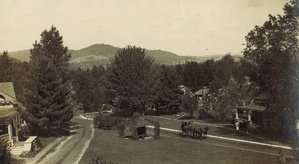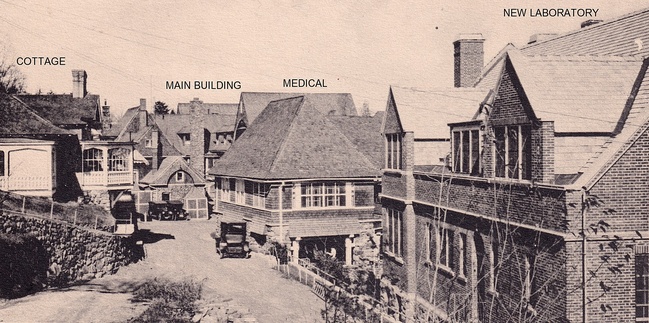 Hoffman Cottage, the Administration Building, the Sheldon and Albert Medical and Reception Pavilion, and the Trudeau Research and Clinical Laboratory building from the rear on the grounds of Trudeau Sanatorium.
Hoffman Cottage, the Administration Building, the Sheldon and Albert Medical and Reception Pavilion, and the Trudeau Research and Clinical Laboratory building from the rear on the grounds of Trudeau Sanatorium.
Historic Saranac Lake collection, #2021.3.11. Gift of the Florence Wright Tuberculosis Postcard Collection.The Administration Building 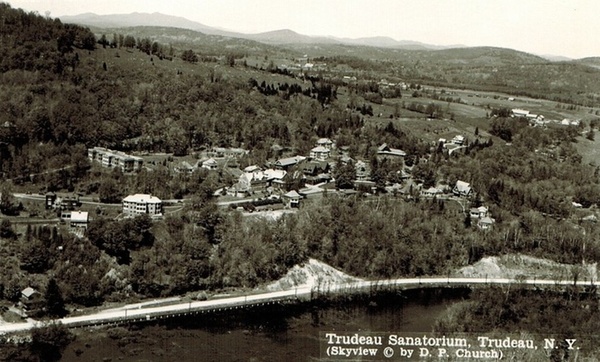 Trudeau Sanatorium, Trudeau, NY, Photo Courtesy of Noreen Oslander
Trudeau Sanatorium, Trudeau, NY, Photo Courtesy of Noreen Oslander 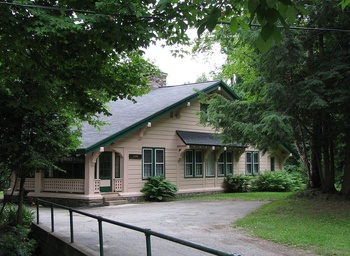 The Gatehouse
The Gatehouse 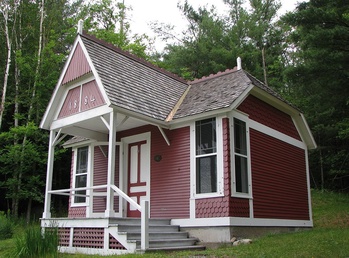 Little Red
Little Red 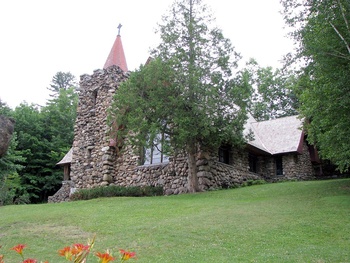 The Chapel
The Chapel  Occupational Therapy Building
Occupational Therapy Building  Halloween at the San, mid-1930s
Halloween at the San, mid-1930s 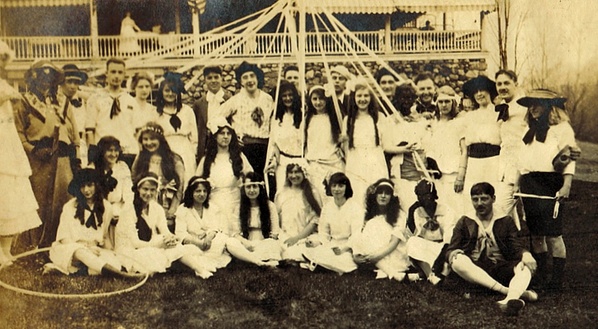 What appears to be a May Day celebration. Undated. Courtesy of the family of Mary McAffey Pinkney.
What appears to be a May Day celebration. Undated. Courtesy of the family of Mary McAffey Pinkney. 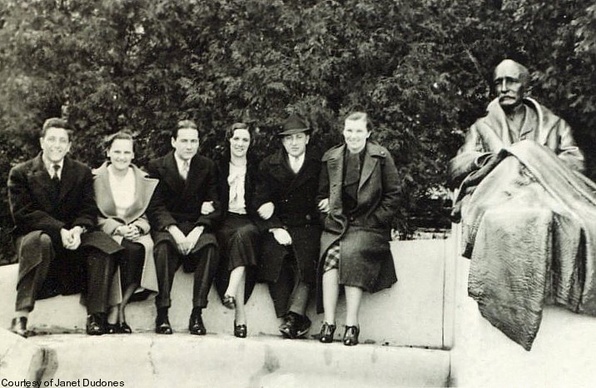 (left to right) unknown, Marie Shay, unknown, Columbia Finelli, Sam Friedman, Theresa Michalek (c. 1934)
(left to right) unknown, Marie Shay, unknown, Columbia Finelli, Sam Friedman, Theresa Michalek (c. 1934)  The Trudeau bus (undated)
The Trudeau bus (undated)  Trudeau staff and summer interns. Seated, from left, Dr. Gordon Meade, Dr. Roger Mitchell, the woman doctor was from New York City doing a short post-graduate course, the others are unknown (Summer, 1953 in front of the Administration Building). The back row were five third year medical students on externship program of six weeks duration. From left: Lansing C. Hoskins, Bernice Russell (now Wylie), unknown, Clay E. Phillips Jr., unknown; the externs were entering their final year of medicine at the University of Rochester. except for Bernice Russell who was at the University of Toronto Medical School. [Information provided by Bernice Russell Wylie, who wrote "Thank you for uploading this picture. It was quite a surprise to find it as I was just reminiscing to myself about the wonderful summer of training and terrific patients and Staff I met while in Saranac."] Historic Saranac Lake collection, TCR #226. The Adirondack Cottage Sanitarium was a tuberculosis sanatorium established in Saranac Lake in 1884 by Dr. Edward Livingston Trudeau. After Trudeau's death in 1915, the institution's name was changed to the Trudeau Sanatorium, following changes in conventional usage.
Trudeau staff and summer interns. Seated, from left, Dr. Gordon Meade, Dr. Roger Mitchell, the woman doctor was from New York City doing a short post-graduate course, the others are unknown (Summer, 1953 in front of the Administration Building). The back row were five third year medical students on externship program of six weeks duration. From left: Lansing C. Hoskins, Bernice Russell (now Wylie), unknown, Clay E. Phillips Jr., unknown; the externs were entering their final year of medicine at the University of Rochester. except for Bernice Russell who was at the University of Toronto Medical School. [Information provided by Bernice Russell Wylie, who wrote "Thank you for uploading this picture. It was quite a surprise to find it as I was just reminiscing to myself about the wonderful summer of training and terrific patients and Staff I met while in Saranac."] Historic Saranac Lake collection, TCR #226. The Adirondack Cottage Sanitarium was a tuberculosis sanatorium established in Saranac Lake in 1884 by Dr. Edward Livingston Trudeau. After Trudeau's death in 1915, the institution's name was changed to the Trudeau Sanatorium, following changes in conventional usage.
Trudeau was born in 1848 in New York City to a family of physicians. During his late teens, his elder brother James contracted tuberculosis and Edward nursed him until his death three months later. At twenty, he enrolled in the College of Physicians and Surgeons at Columbia University (then Columbia College), completing his medical training in 1871. He was diagnosed with tuberculosis in 1873. Following conventional thinking of the times, he went to live in the Adirondacks, seeking a change of climate. He spent as much time as possible in the open and subsequently regained his health. In 1876 he moved to Saranac Lake for the winter and established a small medical practice.
In 1882, Trudeau read about Prussian Dr. Hermann Brehmer's success treating tuberculosis with the "rest cure" in cold, clear mountain air. Following this example, Trudeau founded the Adirondack Cottage Sanitarium in February, 1885. The first patients were two sisters who had been factory workers in New York City. They were treated in a one-room cottage named "Little Red", built for $350 on land donated by the guides and residents of the village. As the sanitarium grew, it would be supported at first by wealthy sportsmen that Trudeau had met at nearby Paul Smith's Hotel, several of whom had built great camps on the nearby St. Regis Lakes.1 Early contributors included John W. Minturn, Anson Phelps Stokes, and Whitelaw Reid.
While the sanitarium did not offer its services free-of-charge, it treated poorer patients at less than cost, and fund-raising was a constant concern. Many physicians and staff members served without pay, and in later years Trudeau commented that he had never been able to pay his staff adequately. Like Trudeau himself, a number of physicians and nurses were themselves infected with tuberculosis. 2 Trudeau admitted mainly patients whose disease was not far advanced. From 1917-1936, 174 people died at the Sanatorium. 3
The sanitarium also developed a school for nursing, and later the Trudeau School of Tuberculosis, which offered six-week summer courses for physicians who wished to learn the latest treatment methods for the disease. 4
In time, far more patients would be drawn to the area than the sanitarium could handle. Many patients were treated in the small, often family-run, cure cottages that developed in the area to meet the demand. Large sanatoria were built at Ray Brook and Gabriels, and in 1927, the Will Rogers Hospital, the last of the institutional sanatoria, was built in Saranac Lake; it is now an assisted living facility, Saranac Village at Will Rogers.
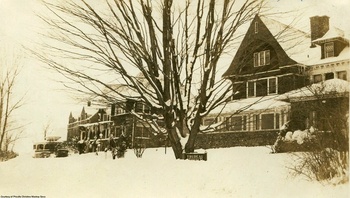 The Administration Building, 1931 The Trudeau Sanatorium closed on December 1, 1954, after the discovery of effective antibiotic treatments for tuberculosis. The property was sold by Trudeau's grandson, Dr. Francis B. Trudeau, Jr., to the American Management Association in 1957. The proceeds were invested in a new medical research facility, the Trudeau Institute, built on Lower Saranac Lake, which opened in 1964; subsequently Little Red and the Trudeau statue were moved to the new site as memorials. A number of the sanatorium buildings have been torn down, and many more have been badly renovated, but a substantial number are still intact. They are not generally open to the public, but tours are offered periodically by Historic Saranac Lake.
The Administration Building, 1931 The Trudeau Sanatorium closed on December 1, 1954, after the discovery of effective antibiotic treatments for tuberculosis. The property was sold by Trudeau's grandson, Dr. Francis B. Trudeau, Jr., to the American Management Association in 1957. The proceeds were invested in a new medical research facility, the Trudeau Institute, built on Lower Saranac Lake, which opened in 1964; subsequently Little Red and the Trudeau statue were moved to the new site as memorials. A number of the sanatorium buildings have been torn down, and many more have been badly renovated, but a substantial number are still intact. They are not generally open to the public, but tours are offered periodically by Historic Saranac Lake.
Patients included:
- Irving Altman
- Dr. Edward R. Baldwin
- Beanie Barnet
- Dr. Norman Bethune
- Dr. Lawrason Brown
- Dr. Daniel Brumfiel
- John Theodore Dalton
- Larry Doyle
- Dr. Hugh M. Kinghorn
- Dr. Gordon Meade
- Florence Mulhern
- Walker Percy
- Richard H. Ray
- Martha Reben
- William H. Scopes
- Allan Seager
- Dr. Norman Shefrin
- Ed Worthington
Malone Palladium, September 11, 1884
Saranac Lake.
The sanitarium is approaching completion. A competent corps of workmen, under the supervision of Mr. WRIGHT, is pushing on the work as rapidly as possible. GEO. WILLIAMS, jr., does the mason work, as he always does his work, in first-class style.
A fair was held last week at the camp of A. P. STOKES, on Birch Island, St. Regis, to raise money to complete the "work on the sanitarium. Time is too limited to give the full title of the buildings.) The fair proved a great success, and one thousand dollars was raised for the good cause.
Ogdensburg Journal, February 24, 1900
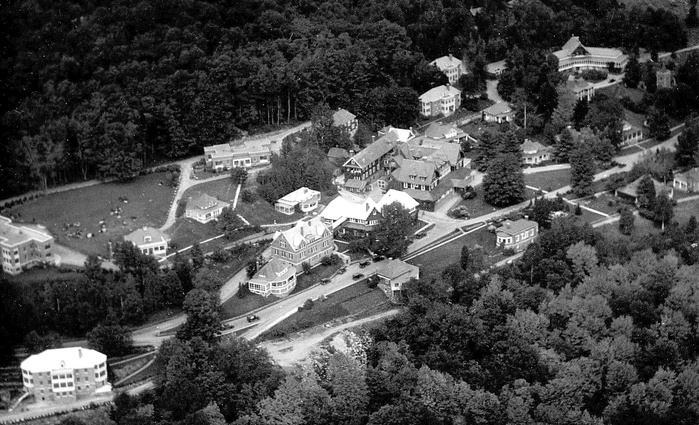 An aerial view of the Sanatorium
An aerial view of the Sanatorium
Photograph #07.56 courtesy of the Adirondack Research Room, Saranac Lake Free LibraryThe Adirondack Sanitarium.
The annual report of Dr. E. L. Trudeau concerning the work done at the Adirondack Sanitarium at Saranac Lake during the year ended Oct. 31, 1899, states that it treated 254 patients during the year, of whom 48 were discharged apparently cured, 47 with disease arrested, 50 improved and 18 unimproved. There were at the close of the year 89 patients still under treatment in the institution. While it is the rule of the sanitarium to accept as patients only those in the incipient state of the disease, the fact is that of the 163 discharged patients no less than 119 were “advanced” or “far advanced” so that the possibilities of absolute cure for tuberculous people seeking treatment in time are seen to be vastly greater than is indicated by the figures quoted. Dr. Trudeau refers to the need the institution has for greater funds, and says:
The increase of applicants has accentuated a great need in our work— i. e., a reception hospital somewhere in Saranac Lake village for the more advanced cases who cannot be taken at the sanitarium. During the entire year, but especially during the summer months, scores of invalids in the last stages of the disease come to Saranac Lake village, either with scanty purses or wholly without funds, full of the new hope which the prospect of admission to the institute has brought them, only to meet the bitter disappointment of finding they cannot be taken in because their cases are beyond the reach of treatment. Too sick often to care for themselves, without money and without friends, their position is most pitiable, and they seek here, often in vain, a place to await the inevitable end. A separate hospital building that would afford a shelter to these stranded and helpless human beings would indeed be a fitting complement to the work of restoration attempted at the sanitarium, and I cannot but think that in the near future the same generosity which has made possible the growth and development of our institution will furnish as well a shelter for those who are beyond the reach of its treatment.
New York Times, August 14, 1904
FAIR AT SARANAC INN.
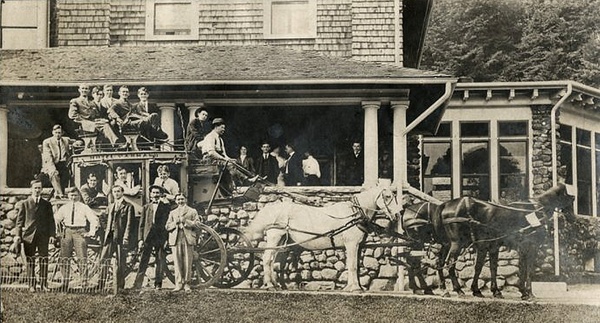 Stagecoach in front of the Administration Building, c. 1910
Stagecoach in front of the Administration Building, c. 1910
Courtesy of the Adirondack ExperienceSpecial to the New York Times.
SARANAC INN, N. Y., Aug. 13.—Much interest is manifest in the fair for the benefit of the Adirondack Cottage Sanitarium that will be held at Saranac Inn Saturday, Aug. 27. The members of the committee include Mrs. D. W. Riddle, Mrs. Thomas Blagden, Mrs. S. A. Swenson, Mrs. Benjamin Douglass, Mrs. J. H. Towne, Mrs. Hoffman Miller, Mrs. S. M. Colgate, Mrs. James R. Sheffield, Mrs. A. H. Belo, Mrs. L. W. Richardson, Miss Grace Lane, Mrs. J. Ben Hart, Mrs. I. N. Seligman, Mrs. M. B. Stearns, Mrs. E. P. Swenson, Mrs. H. M. Dunn, Mrs. S. B. Ferris, Mrs. W.H. Jackson, Mrs. George Ryttenberg, Mrs. J. J. Broome, Mrs. Kriebs, and Miss Walters.
Lake Placid News, April 4, 1924
MANY NEW BUILDINGS FOR TRUDEAU SAN.
Completion of Infirmary, Amusement Pavilion, Dormitories and Cottage
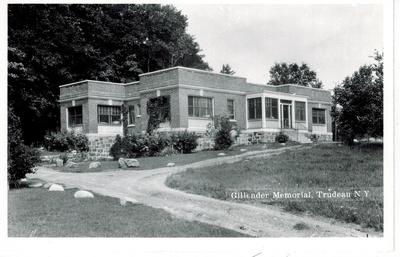 Arthur and Susan Gillender Memorial
Arthur and Susan Gillender Memorial
Extensive plans for construction and expansion will be carried out this year at the Trudeau Sanatorium, according to an announcement made in the thirty-ninth annual report of that institution, which has just been made public. The building program includes the completion of structures already started, and the erection of several new buildings to increase the capacity and efficiency of the sanatorium.
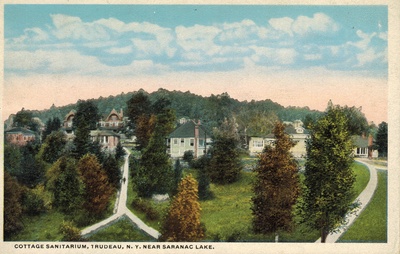 Early postcard of Trudeau Sanitorium, postmarked Jan. 10, 1918. The postcard shows several 4-person cure cottages on the right, with the Administration Building and Library also visible.
Early postcard of Trudeau Sanitorium, postmarked Jan. 10, 1918. The postcard shows several 4-person cure cottages on the right, with the Administration Building and Library also visible.
Among the new buildings to be started this year is a new amusement pavilion, to replace the one destroyed by fire last fall, at a cost of $40,000 to $50,000. Many new features will be included in this building which were lacking in the old structure, with the official's taking into consideration the comfort and desires of the patients to a more marked degree than heretofore.
Other additions to the grounds include the completion of the Ethel Saltus Ludington Memorial Infirmary, the gift of Charles H. Ludington of Philadelphia, and the Arthur and Susan Gillender Memorial cottage, presented thru the Charity Organization society of New York as trustee. Estimates place the cost of the first named building at $150,000 while the second will approximate $32,000.
 The obverse of the above postcard; the card was apparently written by a patient named Mary, to a friend, Reverend John Reagle of Akron, Ohio, a visitor to Saranac Lake. Mary noted that on that day she enjoyed "a fine breakfast, grapes, oatmeal, bacon, graham muffin, glass of milk..." A hearty diet was an important part of the cure at Trudeau
The obverse of the above postcard; the card was apparently written by a patient named Mary, to a friend, Reverend John Reagle of Akron, Ohio, a visitor to Saranac Lake. Mary noted that on that day she enjoyed "a fine breakfast, grapes, oatmeal, bacon, graham muffin, glass of milk..." A hearty diet was an important part of the cure at Trudeau
Plans are also being made for the construction of a new reservoir, that will cost around $10,000, and for a new men's dormitory, with a capacity of 15 beds. This dormitory will cost approximately $10,000. A staff dormitory with outside sleeping quarters for doctors and nurses is also planned with the cost estimated at $15,000 to $30,000.
Detailed explanation of these projects is made in the report of Dr. Edward R. Baldwin, chairman of the executive committee, the introduction of which follows:
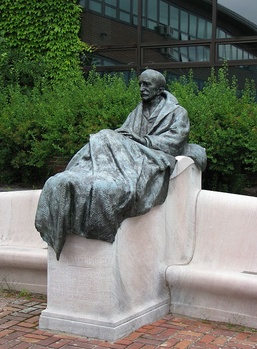 Statue of Dr Edward L. Trudeau, now at the Trudeau Institute "The beginning of the fortieth year of the sanatorium finds the little village of Trudeau in the process of growth. The changes and new construction were mostly begun in the past three months, but with every possible room and bed occupied, the task of making alterations is difficult. It also adds to the expense of operation, causes confusion and withalbrings necessary discomfort to patients and employees. The new laboratory building after long delays was occupied on October 1, and is now in full use, likewise the extension to the dining room and pantry.
Statue of Dr Edward L. Trudeau, now at the Trudeau Institute "The beginning of the fortieth year of the sanatorium finds the little village of Trudeau in the process of growth. The changes and new construction were mostly begun in the past three months, but with every possible room and bed occupied, the task of making alterations is difficult. It also adds to the expense of operation, causes confusion and withalbrings necessary discomfort to patients and employees. The new laboratory building after long delays was occupied on October 1, and is now in full use, likewise the extension to the dining room and pantry.
From the 1951 Annual Report of the Trudeau Sanatorium
THE TRUDEAU SANATORIUM was founded in 1884 by the late Dr. Edward L. Trudeau to help self-supporting people suffering from tuberculosis. The institution was definitely intended for those who could pay only part of the cost. The deficit in maintenance is and always has been made up by annual gifts from the public and income from endowment funds. The charges to patients average three-quarters of the cost, but from fifteen to twenty percent receive further assistance from the Free Bed Funds. Additional endowment for the general maintenance and for the Free Bed Funds is greatly needed and legacies are desired to strengthen the now enlarged institution. The Sanatorium is for the diagnosis, treatment and study of chronic pulmonary disease, especially of patients with favorable types of tuberculosis and for those with limited means. It maintains training courses in the nursing of the tuberculous, Departments of Radiology and Dentistry, Clinical Laboratory, a Rehabilitation Center with a Workshop for Occupational Therapy, also the Mellon Library and the Baker Chapel.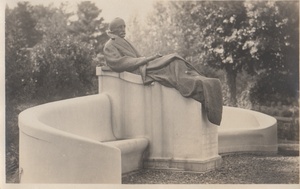 E. L. Trudeau statue by Gutzon Borglum. Courtesy of Peter MacIntyre
E. L. Trudeau statue by Gutzon Borglum. Courtesy of Peter MacIntyre
Note: One of the admission requirements was an inability to pay the full cost of private treatment, but an exception was made for doctors, many of whom worked at the sanatorium without pay, and later established practices within the village.
ANNUAL REPORT OF THE PRESIDENT OF TRUDEAU SANATORIUM AND FOUNDATION
FRANCIS B. TRUDEAU, M.D.
THE YEAR 1951 has indeed been an exciting one in the investigation of new drugs and new surgical approaches in the treatment of tuberculosis. Both the Sanatorium and the Foundation have played their part in the overall program.
 E. L. Trudeau statue by Gutzon Borglum. Courtesy of Peter MacIntyre
E. L. Trudeau statue by Gutzon Borglum. Courtesy of Peter MacIntyre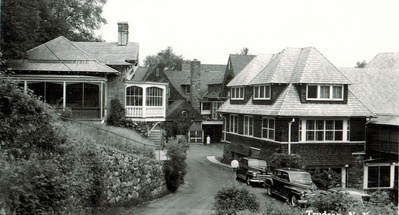 At front left is the Hoffman Cottage, with its cure porch hanging over the edge of the road. It was later torn down. The photo is looking straight into the back of the Administration Building service area. To the right is the Medical and Reception Building. The road curves right between the two last named. c. 1945. Courtesy of Noreen OslanderIt is interesting to contemplate for a moment a few of the changes which have occurred since the turn of the century in the tuberculosis statistics. In 1900 the U.S. mortality rate due to tuberculosis was approximately 200 per 100,000 population. Today the mortality rate is 22 deaths per 100,000 population. It is during the past 6 years, however, that the most striking changes in mortality rates have been noted throughout the world. Declines of from 32 to 78 per cent have occurred in various areas and in our own United States the rate has fallen 41 per cent during this period.
At front left is the Hoffman Cottage, with its cure porch hanging over the edge of the road. It was later torn down. The photo is looking straight into the back of the Administration Building service area. To the right is the Medical and Reception Building. The road curves right between the two last named. c. 1945. Courtesy of Noreen OslanderIt is interesting to contemplate for a moment a few of the changes which have occurred since the turn of the century in the tuberculosis statistics. In 1900 the U.S. mortality rate due to tuberculosis was approximately 200 per 100,000 population. Today the mortality rate is 22 deaths per 100,000 population. It is during the past 6 years, however, that the most striking changes in mortality rates have been noted throughout the world. Declines of from 32 to 78 per cent have occurred in various areas and in our own United States the rate has fallen 41 per cent during this period.
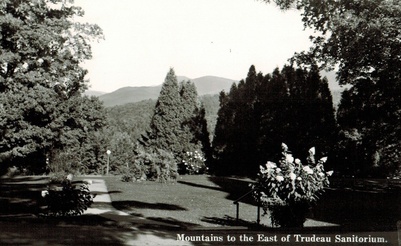 Courtesy of Noreen OslanderIn spite of these dramatic changes, there has been little alteration in the number of active cases in this country, and the number of newly discovered cases seems to be increasing each year, due largely, many believe, to the constantly increasing number of mass x-ray surveys.
Courtesy of Noreen OslanderIn spite of these dramatic changes, there has been little alteration in the number of active cases in this country, and the number of newly discovered cases seems to be increasing each year, due largely, many believe, to the constantly increasing number of mass x-ray surveys.
Here at Trudeau, however, our daily patient average has dropped from 174 in 1949 to 168 in 1950 and to 153 for the year under consideration. This decrease in our patient population is due to many factors, two of which may be the large number of excellent county, state and federal sanatoria where good care and treatment may be obtained without cost to the patient, and also the tendency for home treatment brought about by the advent of the new drugs. In the meantime, our annual operational deficit at the Sanatorium has now reached over $100,000 which, I am thankful to say, has been taken care of by approximately $55,000 from income from investments and the remainder from donations due largely to our campaign committee, to whom I owe my sincere thanks for making it possible to end the year with a few thousand dollars on the black side of the ledger.
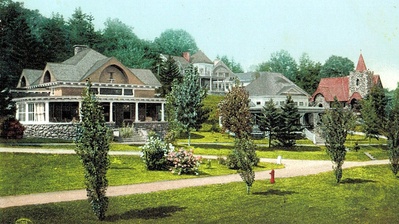 Ladd Cottage, Anderson Cottage, Resident Physician's Cottage, Childs Infirmary,
Ladd Cottage, Anderson Cottage, Resident Physician's Cottage, Childs Infirmary,
Baker Chapel. Courtesy of Noreen OslanderMedically, the year has been a very encouraging one because streptomycin and other forms of chemotherapy have proven to be real allies in our fight against tuberculosis. In addition, surgery is playing an important role in the treatment because of new techniques combined with the use of the new drugs, blood from blood banks, and special anesthesia. Gone are the days of old when the entire treatment consisted of bedrest and gradually increasing exercise plus supportive therapy in the form of a few well-known drugs such as aspirin, codeine, cathartics, and sleeping pills. Today, science offers us our choice of nearly a dozen different preparations and combinations of them and the same is true of the varied types of surgical procedures. The most dramatic of these by far is the surgical removal of the diseased area of the lung. This is a far cry from the days when our institution was founded, now nearly 70 years ago. We hope that we have done and are doing our share towards bringing about the beneficial changes just described.
Aside from the care of patients, our medical staff has been busy trying, through follow-up records of ex-patients extending over so many years, to answer by a statistical study such important questions as (1) the value of strict bedrest which is advocated by many today as compared with the not so strict regimen of years ago, (2) what are the comparative results of other forms of treatment, such as pneumoperitoneum and pneumothorax and what do statistics say in helping us to evaluate the true place of surgery in the treatment of tuberculosis, and (3) what is the prognostic significance of cases with cavity as compared with those patients in whom no cavity has developed? In addition, much work and study has been done on the clinical effects of the new drugs such as streptomycin and PAS. During the year 8 medical papers have been published.
The Foundation has also been active and has played its part during the past year. A total of ten scientific papers were published; three from the Department of Physiology, three from the Trudeau Laboratory, two from the Department of Biochemistry, and two from the Saranac Laboratory. For one of the latter two papers mentioned, the Director of the Foundation, Dr. Arthur J. Vorwald, was given the citation for excellence in medical authorship by the Industrial Medical Association at their Atlantic City meeting in April. On October 9, 1951, a symposium on lung diseases in the asbestos industry was held at the Saranac Laboratory and attended by approximately 40 members of the Asbestos Producers Association of Canada.
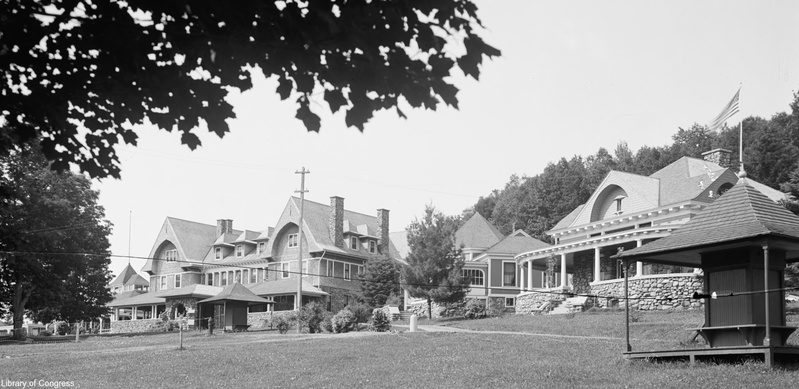 The Administration Building, Trudeau and Anderson Cottages, c. 1902, William Henry Jackson
The Administration Building, Trudeau and Anderson Cottages, c. 1902, William Henry Jackson
During the year the Foundation received a $10,000 grant from the Damon Runyon Fund for research on cancer of the lung; $14,000 from the United States Public Health Service for clinical research in pulmonary disability, and the renewal of a $25,000 grant of the United States Public Health Service for the continuation of the study of streptomycin on resistant strains of the tubercle bacillus. These as well as the renewal of other grants from the Navy, the National Tuberculosis Association and from many industries for studies already started, made a total of approximately $300,000 for the year. In addition, the Directors and the heads of the various departments presented papers and discussed problems before various medical and industrial organizations in the United States and Canada.
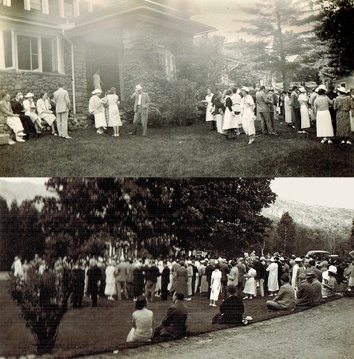 "Reception on Lawn in Front of Main Building" courtesy of Peter MacIntyre
"Reception on Lawn in Front of Main Building" courtesy of Peter MacIntyre "Gathering on Lawn in Front of Main Building" courtesy of Peter MacIntyreUnder the direction of Dr. E. N. Packard, former Medical Director of the Sanatorium, the Trudeau School of Tuberculosis held its annual session during the month of May. It was attended by 28 doctors, of whom 15 came from foreign countries. We hope that these men felt that their stay with us was worthwhile. At the annual meeting of the Board of Trustees, Dr. Gordon M. Meade, Director of the Sanatorium and Dr. Arthur J. Vorwald, Director of the Foundation, were jointly placed in charge of the School for the coming year following Dr. Packard's resignation. During the past 13 years this School has been supported by the Lillia Babbitt Hyde Foundation through its President, Mr. Charles C. Harris, to whom I wish to extend our sincere thanks and gratitude.
"Gathering on Lawn in Front of Main Building" courtesy of Peter MacIntyreUnder the direction of Dr. E. N. Packard, former Medical Director of the Sanatorium, the Trudeau School of Tuberculosis held its annual session during the month of May. It was attended by 28 doctors, of whom 15 came from foreign countries. We hope that these men felt that their stay with us was worthwhile. At the annual meeting of the Board of Trustees, Dr. Gordon M. Meade, Director of the Sanatorium and Dr. Arthur J. Vorwald, Director of the Foundation, were jointly placed in charge of the School for the coming year following Dr. Packard's resignation. During the past 13 years this School has been supported by the Lillia Babbitt Hyde Foundation through its President, Mr. Charles C. Harris, to whom I wish to extend our sincere thanks and gratitude.
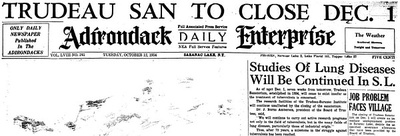 Adirondack Daily Enterprise, Ocotober 12, 1954
Adirondack Daily Enterprise, Ocotober 12, 1954
 St. Patrick's Day Menu, 1935
St. Patrick's Day Menu, 1935
Courtesy of Jan Dudones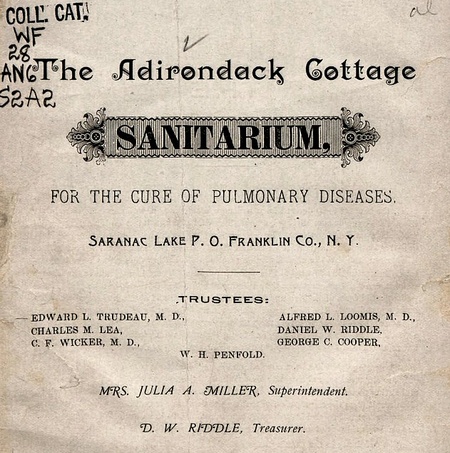 First page of an 1887 Brochure
First page of an 1887 Brochure
Courtesy of the U.S. National Library of Medicine
FUTURE: We have been increasingly aware of the possibility that private tuberculosis sanatoria may reach the limit of their usefulness in the foreseeable future, and if this should occur, we intend to be prepared to use at least a portion of our excellent facilities and personnel for other purposes-We have had many suggestions for work in other fields of medical endeavor under advisement for some time. Whether the Sanatorium should continue to limit its studies and efforts solely to tuberculosis depends on several factors: on the number of tuberculosis cases in the country, and on the percent of these who may require private sanatorium care; our decision should also depend upon the eventual result of the various new drugs on our patient population; and if and when the ultimate cure or the "golden bullet" should be discovered, its effect upon our private tuberculosis care in particular must be carefully evaluated. Let us consider these points in more detail. In order to give you a true and accurate picture of the incidence of tuberculosis in this country, I would like to refer you to the front cover of the June, 1952 Bulletin of the National Tuberculosis Journal. Here it states simply that there are in the United States 200,000 cases of known active disease, 150,000 unknown active cases, and 150,000 new cases annually. Certainly this seems to indicate fairly clearly that our work in this field is far from finished, even though it would be impossible to predict just how many of these cases should and would come to Trudeau. As to the effect of the new drugs on the number of our patients, undoubtedly many will try using them at home under private care. To me this would seem to be the time that specialized care in good sanatoria with available research laboratories is most essential, for so little is known of the proper usage, of the lasting good as well as of the harmful effects of these drugs that careful daily observations and studies should be made by specialized physicians with competent laboratory facilities.
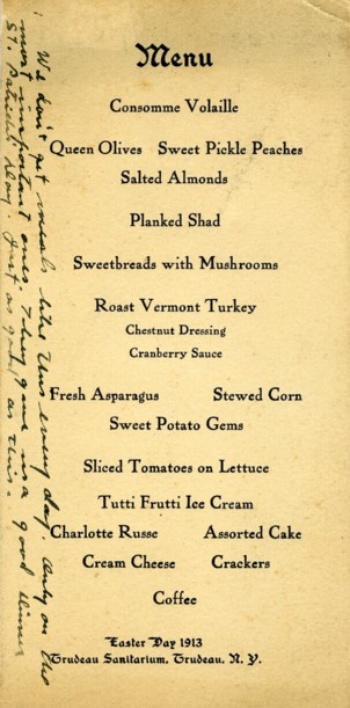 Easter menu at the Sanatorium, 1914. The notation at the side reads "We don't get meals like this every day. Only on the most important ones. They gave us a good Dinner St. Patrick's Day. Just as good as this."
Easter menu at the Sanatorium, 1914. The notation at the side reads "We don't get meals like this every day. Only on the most important ones. They gave us a good Dinner St. Patrick's Day. Just as good as this." 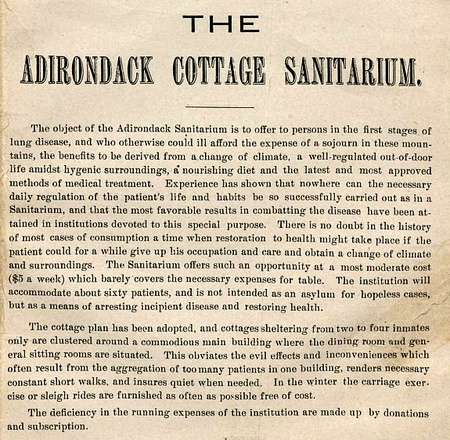 Page 2, 1887 BrochureAs to the effect of the possible discovery of the "cure" for tuberculosis on the Sanatorium and Foundation, I feel certain that several years of study and observation of the adequacy of any drug would be required before its positive curative value could be established. Thus, I am confident that for many years we will have a role in the final conquest of this disease — even now the greatest killer of American youth between 15 and 35.
Page 2, 1887 BrochureAs to the effect of the possible discovery of the "cure" for tuberculosis on the Sanatorium and Foundation, I feel certain that several years of study and observation of the adequacy of any drug would be required before its positive curative value could be established. Thus, I am confident that for many years we will have a role in the final conquest of this disease — even now the greatest killer of American youth between 15 and 35.
We are particularly fortunate in having facilities for research, diagnosis, treatment, and rehabilitation which are among the finest of their type in the north country. Should we not be able to fill our beds with patients suffering from tuberculosis, we shall be able to find other fields of usefulness for them. We have discussed the possibility of establishing a general diagnostic clinic to serve our north country and also the possibility of allocating a certain number of cottages to the care of patients with other types of chronic disease or as a small rehabilitation unit in connection with the Saranac Lake Rehabilitation Guild, which has been operating very successfully in Saranac Lake for the past twelve years.
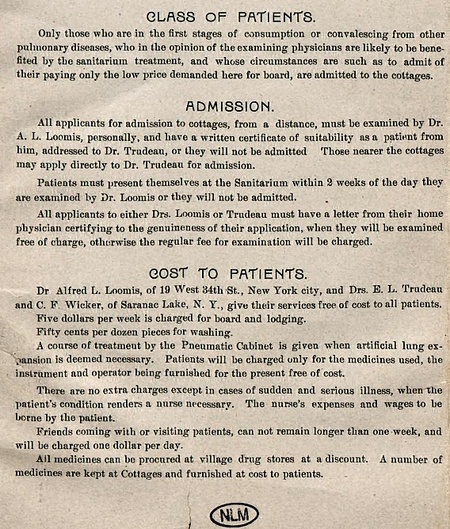 Page 2, 1887 BrochureWe look forward with anticipation to future usefulness.
Page 2, 1887 BrochureWe look forward with anticipation to future usefulness.
See also
- Trudeau Sanatorium Historic District
- Azel Lathrop
- D. Ogden Mills Training School for Nurses
- A History of Saranac Lake for a more detailed history
- A Most Critical Transition: the End of the TB Era, Adirondack Daily Enterprise article by Mary Hotaling, February 6, 2007.
- Thursday Evening Club
- Rules and Information for Patients
- Lost Trudeau Sanatorium Buildings
-
Sanitaria for the Treatment of Incipient Tuberculosis, a paper by E.L. Trudeau
Sources
- National Register of Historic Places Multiple Property Documentation-- "Cure Industry Resources in the Village of Saranac Lake, Essex and Franklin Co., NY," by Mary Hotaling and Rachel D. Bliven, 1992
- Cole, Elizabeth, Fifty Years at Trudeau Sanatorium, Saranac Lake, NY: The Currier Press, 1935.
- Donaldson, Alfred L., A History of the Adirondacks. New York: Century, 1921. ISBN 0-916346-26-8. (reprint) at GoogleBooks
- Gallos, Philip L., Cure Cottages of Saranac Lake, Historic Saranac Lake, 1985, ISBN 0-9615159-0-2.
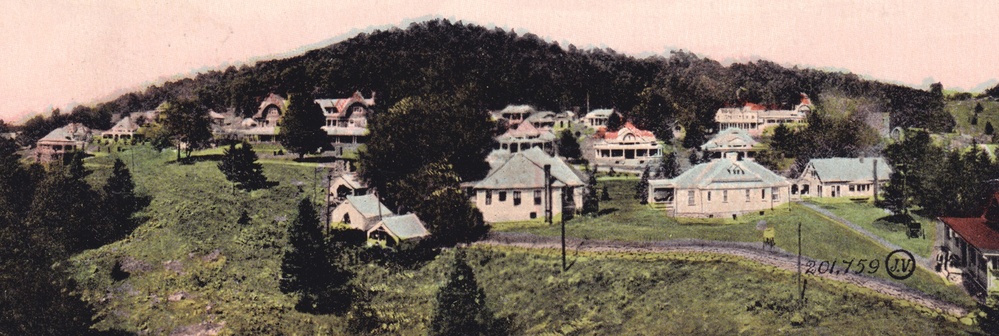 Postcard showing the Adirondack Cottage Sanitarium campus, looking west.
Postcard showing the Adirondack Cottage Sanitarium campus, looking west.
The Administration Building and Trudeau, Ladd, and Anderson Cottages are visible; note the cure tents, left center foreground. Undated, but postmarked July 14, 1910
Historic Saranac Lake collection, #2021.3.39. Gift of the Florence Wright Tuberculosis Postcard Collection
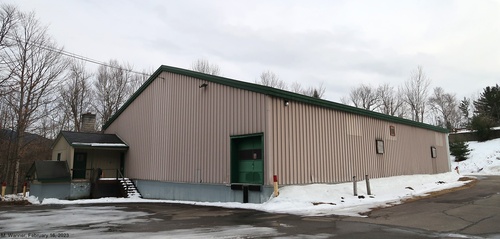 AMA Gymnasium
AMA Gymnasium
It was built probably in the early 60s, and it was originally a gymnasium. The AMA organization had their own basketball team and they would travel around and play against teams from other communities. The team wasn't made up of employees, but they were people who would come here for management training. The neighborhood kids from Park Avenue discovered the doors were open and they would go in and play basketball.
At some point the building became a computer center for the AMA.
External links
- Historic Saranac Lake - A brief history
- Trudeau Institute, 1884-2008
- An 1885 description of the sanatarium
- ''New York Times'', "DOINGS IN THE ADIRONDACKS; Prominent Women Devoting Much of their time to Charity Work", July 23, 1905
- ''New York Times'', "Francis B. Trudeau, 75, Founder Of Biological Research Institute", April 27, 1995
Comments
Footnotes
1. National Register of Historic Places Multiple Property Documentation: Cure Industry Resources in the Village of Saranac Lake, Essex and Franklin Co., NY, (291 KB), Mary Hotaling and Rachel D. Bliven, 1992, National Park Service
2. Donaldson, p. 257
3. Phone Interview with North Elba Town Clerk, consulting death records, 2011
4. Donaldson, p. 258 fn.


